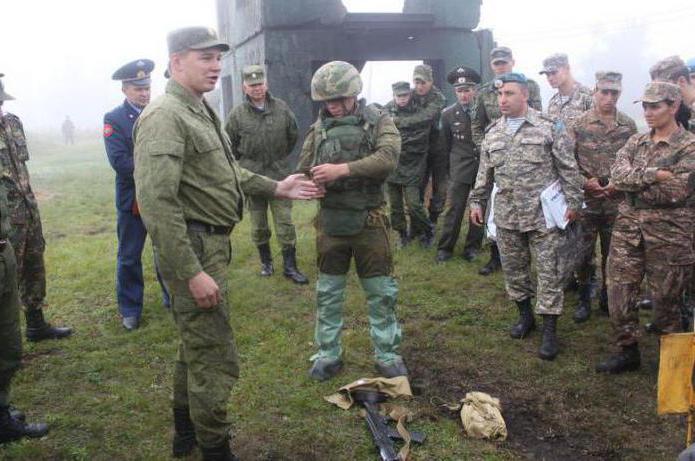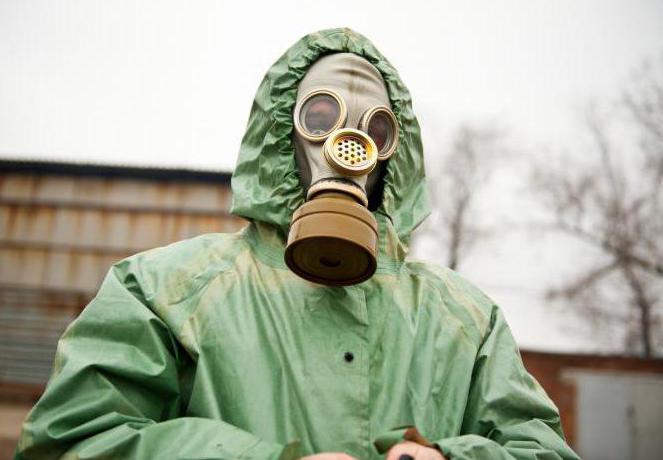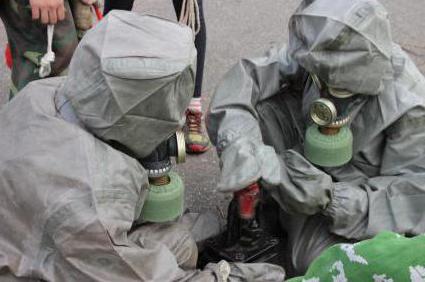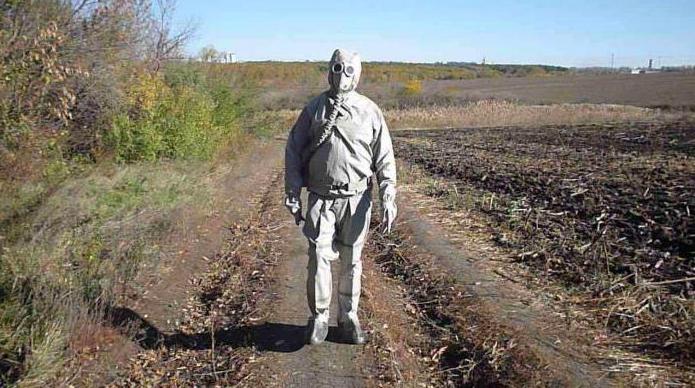Temporary indicators for RBZ. “Individual and collective means of RHBZ
Standards during classes and training are fulfilled using serviceable, adjusted, tested and assigned equipment to the serviceman personal protection.
Personal protective equipment, radiation (chemical) reconnaissance and control devices must be fully equipped, stowed and secured in place.
The standard is considered fulfilled if the conditions for its implementation are met during work and there have been no violations of safety requirements, as well as charters, manuals, instructions and manuals.
If, when working out the standard, the student makes at least one mistake that could lead to injury (defeat) to personnel, breakdown of equipment, weapons or an accident, fulfillment of the standard is stopped and the student is assessed for "unsatisfactory" .
For violation of the sequence of compliance with the standard, which did not lead to accidents, breakdown (damage) of equipment and weapons, as well as for each error leading to a violation of the conditions for fulfilling the standard, the requirements of charters, manuals, manuals, instructions, the score is reduced by one point.
When standards are met by personnel wearing skin protective equipment (OZK, L-1, etc.), the time increases by 25%, and when working in respiratory protection equipment (gas mask, respirator) - by 10%, except for standards, the implementation of which provided only in protective equipment.
At an air temperature of minus 10°С and below, plus 300°
Technical malfunctions of personal protective equipment, devices and kits discovered during the implementation of the standard are not eliminated (unless they interfere with the implementation of the standard). After completing the standard, the trainee reports on any defects identified.
The time for fulfilling the standard by a military personnel (unit) is counted using a stopwatch from the moment the command is given “To comply with the standard - START”
The procedure for determining the assessment for meeting standards
If the standard is practiced several times during the training process, then the grade for its implementation is determined by the last result shown or by the result of the control lesson.
An individual assessment for a serviceman for fulfilling several standards for chemical safety is determined based on the marks received for fulfilling each standard, and is considered:
| "Great"" | if at least 90% of the tested standards are rated positively, while at least 50% of the standards are rated “excellent” |
| "Fine" | if at least 80% of the tested standards are rated positively, while at least 50% of the standards are rated at least “good” |
| "satisfactorily" | if at least 70% of the standards are assessed positively, and when assessed according to three standards, two are assessed positively, one of them is not lower than “good” |
| "unsatisfactory" | if the conditions for a “satisfactory” rating are not met |
The grade for fulfilling single standards for the unit is derived from the individual assessments of students and is determined:
Standard No. 1
Conditions, procedure for implementation and guidelines for developing standard No. 1
| Name standard | Putting on a gas mask or respirator |
| Conditions execution standard | Trainees as part of a unit are in position, wearing combat or special equipment, conducting combat operations, resting at a rest stop, etc. Gas masks and respirators are in the “stowed” position. |
| Order execution standard | The leader of the lesson unexpectedly gives a command "GASES" or “Respirator - WEAR”. Students, holding their breath and closing their eyes, put on gas masks or respirators, exhale deeply and resume breathing. The time for fulfilling the standard is counted from the issuance of the command "GASES" or “Respirator - WEAR” until the trainee resumes breathing after putting on a gas mask (respirator). |
| Methodical instructions for working out standard | The rules for putting on a gas mask in various positions are determined by the Manual on the use of personal protective equipment. However, you can put on a gas mask using other methods, but their use should ensure quick and correct donning and safety of the front part of the gas mask. If it becomes more difficult to breathe while using the gas mask, you need to lightly tap the box with your hand to shake off dust or snow from the cover. If it is still difficult to breathe after this, then, without removing the gas mask, remove the cover, shake off dust or snow from it and quickly put it on the box. After using the gas mask in the “combat” position, remove the cover from the box and shake off the dust. Take off the gas mask on command "Gas mask - REMOVE" or “Protective means - REMOVE”, and put into a gas mask bag on command "ADDED". After each use of the respirator, decontaminate it by removing dust from the outer part of the half mask (by knocking it out, shaking it out or lightly tapping it on an object). Wipe the inner surface of the half mask with a damp swab, but do not turn the half mask inside out. Then place the respirator in a bag, seal it with a ring and place it in a bag for a gas mask. Remove the respirator upon command "Respirator - REMOVE" or “Protective equipment - REMOVE”, and put it into a gas mask bag on command - "ADDED". |
Trainees as part of a unit are in position, wearing combat or special equipment, conducting combat operations, resting at a rest stop, etc. Gas masks and respirators in the “stowed” position.
Suddenly the command “Gases” or “Put on respirators” is given. Trainees wear gas masks or respirators.
Note.
The numerator indicates the time to put on a gas mask, and the denominator indicates the time for putting on a respirator.
^
Errors that reduce the score by one point
1. When putting on a gas mask, the student did not close his eyes and hold his breath, or after putting on did not exhale completely.
2. The helmet-mask is worn askew or the connecting tube is twisted.
3. The ends of the nose clip of the respirator are not pressed against the nose.
Errors that determine the “unsatisfactory” rating
1. The formation of such folds or distortions is allowed, in which outside air can penetrate under the helmet-mask.
2. The nut of the connecting tube is not fully screwed in.
3. The size of the helmet-mask is incorrectly selected.
Protecting human skin from biological and toxic substances, from radiation damage, the combined arms protective kit also reduces the contamination of uniforms, shoes, equipment and individual weapons. How to put on OZK according to the standard will be discussed in this article.
Purpose
OZK is manufactured in combination with filtering personal protective equipment. If it is put on in advance, it can protect the fighter from the consequences of a nuclear explosion (light radiation), from open flames and fire mixtures, almost all thermal factors will not have such a destructive effect on him, and besides, the equipment located under the kit will not suffer significantly either. It is not intended for constant wear, it is used periodically, but every serviceman should know how to put on the OZK quickly, and do it on time.
If contamination by toxic substances is expected, damage by biological agents or radiation is threatened, then general protective kits are subjected to special treatment for repeated use. The protective kit is assembled directly in the units, where soldiers learn how to withstand chemical and biological contamination (primarily how to put on OZK).
Kit components
In departments and warehouses, protective raincoats with covers (OP-1M), gloves, OZK stockings, covers for gloves and stockings are ordered and supplied separately. Such a complete set should consist of seventeen components. This is a protective raincoat OZK OP-1M, a drawstring with a back loop and a loop for the thumbs, steel frames, four fasteners, a central pin and eighteen more pieces, raincoat holders, a strap, covers for the raincoat, gloves and stockings, the actual protective stockings, gloves summer BL-1M and winter gloves with insulating liners BZ-1M.
The OZK device is packaged in covers, and the fasteners and pegs are packed in gauze bags. Judging by the configuration, military personnel need special knowledge on how to put on the OZK. First, the kit must be airtight. To ensure this quality, the bottom of the sleeves is tightened with elastic bands, and the size of the hood needs to be adjusted with a drawstring. The sleeves themselves are secured with loops that fit over the fingers. The OZK raincoat is fastened with pegs.

Device
In order to put on the raincoat of a combined arms protective kit as a jumpsuit, there are holders, a central peg, straps with elastic bands and fasteners. There is a special pocket on the left sleeve to store spare clips and pins.
Putting on the OZK is done in stages, but you can very quickly transfer the cloak into a combat position as a cape. This is facilitated by a case designed to be stored or carried using steel frames on the back. It is made of simple fabric, and the raincoat itself is made of rubberized fabric; it is also good in bad weather.
For convenience, the cover has two pegs in the holders and two straps with slots for them to quickly fasten everything. Two pairs of steel frames are needed to secure the raincoat in the case on the back. The ends of the straps are connected with braid so that the cover opens as quickly as possible. Putting on a full OZK is sometimes impossible, but the transformation of the cloak into the form of a cape occurs instantly.
![]()
Stockings and gloves
Protective stockings consist of a pair of stockings themselves, six pegs and braid (2 pcs.). The pegs are secured to a piece of rubberized fabric. Stockings are attached to the legs using braid and straps. The soles are made of pure rubber, and the shafts are made of rubberized fabric.
There are two types of protective gloves included in the kit: summer BL-1M and winter BZ-1M. The first ones have five fingers, and the second ones have two, both are made of rubber, but the winter kit includes insulation inserts. The “traveling” and “ready” positions require stockings and gloves to be in special cases.
The procedure for putting on the OZK
As already mentioned, it can be used in two forms in a combat position - as a cape worn in the sleeves, and as a jumpsuit. The cape is used when the enemy suddenly uses napalm, toxic chemicals or bacteriological aerosols.
The cape is put on at the signal “Gas” or “Chemical alarm” after a command or independently at the first, even unreliable, signs of the enemy using biological or chemical weapons. Also, everyone outside the shelters needs to put down their weapons, temporarily stop breathing and close their eyes. Next, you need to act quickly. Take off your headdress and helmet, put on a gas mask, exhale, resume breathing and open your eyes. Remember the procedure for putting on the OZK.

Actions
If the raincoat is without a cover, you need to unfasten the hood drawer on the roll to open it, but if it is in a cover, then, sharply pulling the ribbon, simply open it. Throw a cloak over your shoulders, put on a hood and cover the floors. Then you need to lie down or sit down so as to cover your shoes, uniform, headdress and helmet, and weapons with a cloak. This is necessary in order to protect everything from infection.
If the cloak is placed unfolded on the ground, you need to take it by the top with both hands and put it on like a cape, throwing it over your head with one swing. Then immediately use an individual anti-chemical package. When the initial cloud has passed, you need to throw off your cloak, which is already infected, put on a helmet for protection, remove stockings from the case, put on and fasten them, remove gloves from the case, re-treat your hands with the PPI packet and immediately put on gloves. If the first signs of sarin damage appear, you should use personal first aid kit remedy for poisoning. If a chemical or bacteriological alarm catches military personnel while moving in open transport, if possible, a stop is made to put on the combined arms protective kit OZK.

Teams
You need to put on your OZK in advance, as soon as the command “Put on sleeves, gloves, and stockings! Gas!” It is necessary to immediately put down the weapon and put on stockings. Tie two ribbons on the belt, fasten the straps, put on a helmet for protection, put on gloves, open the cover of the raincoat, carefully put it on so that the loops on the low sleeves fall on the thumbs on top of the gloves. Then put the hood on the helmet and fasten the cloak. After that, take the weapon.
If all these actions are carried out in a shelter or structure, after the command “Put on a protective suit! Gases!” you must immediately put down your weapon, quickly remove your equipment and bag with a gas mask, headgear and helmet, goggles and respirator (if they were worn). Then put on the OZK.

How to quickly put on the whole set
Place the raincoat in the cover on the ground, fastening it with the straps and securing the braid to the belt (on the belt), open the raincoat cover, grab the holders and put on the raincoat so that the cover is under the raincoat on the back. Put it on the sleeves, thread the ends of the holders into the frames at the bottom of the raincoat and secure them there, fasten the holes onto the pegs in the center, first the right floor, then the left, securing them, fasten the pegs on the floors of the raincoat so that each of them covers the leg - the left floor, the left one, and the right sex - the right. After this, you need to secure the pin holders below the central one, fasten the side straps, wrapping them under the knees.
Now only the top pegs remain unfastened. Field equipment and a bag for a gas mask are put on over the raincoat, and the gas mask itself is transferred to the combat position. It’s time to put on the balaclava, fasten it and tuck it under the jacket, then put on the headdress and helmet, and the hood of the raincoat on it. Now fasten the top pegs and roll up the sleeves. Take out the gloves, put them on so that the low sleeves of the raincoat are lowered to the cuffs of the gloves, and the loops are on the thumbs. Take a weapon. In areas contaminated with toxic chemicals, the procedure for putting on an OZK in the form of overalls is the same, only the gas mask is in the “Gas” position, and it cannot be removed while putting on the kit.
Removal
Removing an infected cloak that is worn as a cape must follow strictly defined rules. Turn your face in the direction from which the wind is blowing, place or put down your weapon. If the raincoat has a cover, untie the holders, hold them lightly, and pull them out of the frames. Use the holders to lift the cloak and throw it down so that the infected side hits the ground. If there was no cover, you need to remove the hood from your head, untie the holders from the belt, lift the cloak and throw it back.
When traveling in open vehicles, military personnel remove their OZK after stopping and disembarking. A raincoat worn in sleeves that is contaminated with toxic chemicals or bacterial aerosols should be removed only if it cannot be disinfected or degassed. The overalls are also removed after the command “Remove protective kit”.
When removing the OZK, you must carefully ensure that open areas of the body do not touch the infected outside. If necessary, degassing is carried out using the IDP-1 recipe. First of all, weapons, gas mask. When the kit is removed, you need to immediately move away from the infected person to the windward side, treat the equipment, uniform, shoes and bag for the gas mask with the DPS-1 package, then remove the gloves and gas mask.
Standard
The standard for wearing OZK for assessment is:
- In the form of overalls - 4 min. 30 sec. (the command is given: “Put on a protective suit! Gases!”).
- In the form of a raincoat - 3 min. (the command is given: “Put on sleeves, stockings, gloves. Gases!”).
The standard for putting on OZK is worked out during training and exercises. Only serviceable, fitted, tested and assigned kits to specific military personnel are used for this purpose. The dimensions of the OZK are the most important for compliance with regulations. All protective equipment and instruments for control and reconnaissance (chemical or radiation) must be fully equipped, stacked correctly and secured in the proper places.
The standard will be considered fulfilled if during the inspection the conditions of fulfillment are met and there are no violations of safety requirements, manuals, instructions and charters. The trainee receives an “unsatisfactory” rating if at least one mistake was made that could lead to either injury (that is, defeat) to personnel or damage to weapons or equipment, that is, to an accident. The modern and lightweight protective suit L-1 is shown in the picture. It is more accessible to use, even fishermen and hunters often buy them for themselves.

Time
When standards are met for the use of skin protection products (whether L-1, etc.), the implementation time increases by a quarter, but if the standard is established for respiratory protection (respirator, gas mask), it increases by ten percent.
If the temperature is below -10 Celsius or above +30, as well as during heavy rain or snowfall, the time increases by twenty percent. If a standard for putting on OZK is established for night operations, 30% is added to this time.
- Kliment Efremovich Voroshilov
- Hieromartyr Hermogenes, Bishop of Tobolsk and Siberia and the murdered priest Peter Karelin like him At the Tobolsk See
- Russian statesman, Minister of Internal Affairs Vyacheslav Konstantinovich Plehve was born. What are the main areas of activity of Plehve V
- Sergey Yesenin - I've never been this tired before
- Myra Lycian - the place of sanctification of St. Nicholas the Wonderworker Temple of St. Nicholas the Wonderworker in the world
- English money: history and interesting facts What money is in Great Britain
- Ceres, ancient Roman goddess The art of agriculture from Ceres
- Who is Viktor Bout really?
- Cardinal Chen: “The Vatican Secretary of State is a man of little faith with erroneous opinions Who is considered young in relation to cardinals
- The meaning of the name Yaroslav, origin, character and fate
- How do people become terrorists?
- Historical portraits of Yaroslav the Wise, Vladimir Monomakh, Ivan III and Ivan the Terrible, painted by O
- Judaism: basic ideas. History of Judaism. Commandments of Judaism. Judaism briefly about religion Judaism regions of distribution main centers
- Ways to protect property in ancient Rome
- What is psi? Where, besides psychology, is the letter psi used?
- "White" army: goals, driving forces, fundamental ideas
- Gleden Monastery iconostasis
- Krutitskoye Metochion Temple Krutitskoye Metochion
- Nikishin Nikolay Nikolaevich
- Important events and significant dates in October International Investment Forum in Sochi









